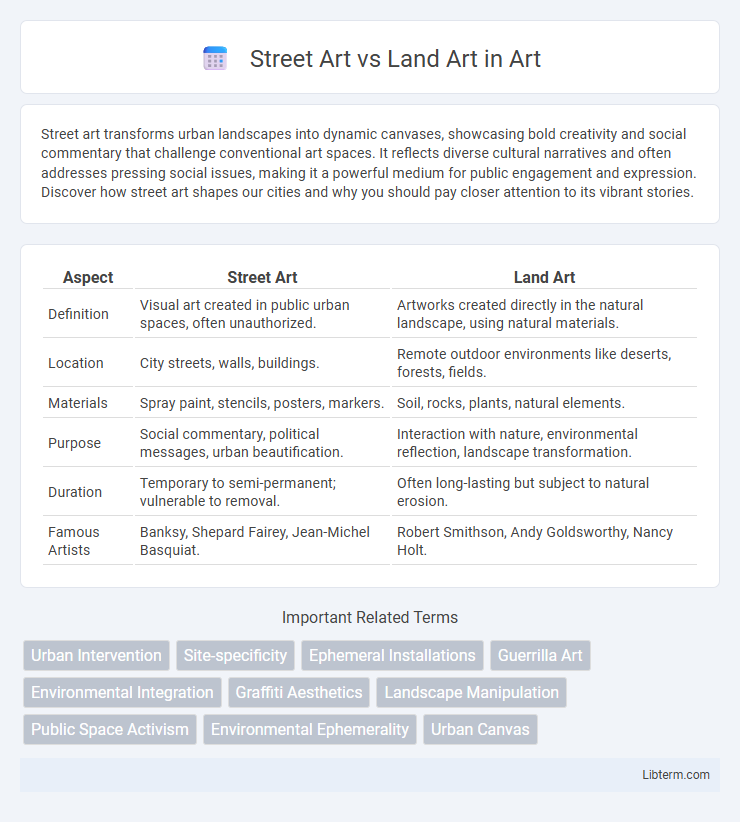Street art transforms urban landscapes into dynamic canvases, showcasing bold creativity and social commentary that challenge conventional art spaces. It reflects diverse cultural narratives and often addresses pressing social issues, making it a powerful medium for public engagement and expression. Discover how street art shapes our cities and why you should pay closer attention to its vibrant stories.
Table of Comparison
| Aspect | Street Art | Land Art |
|---|---|---|
| Definition | Visual art created in public urban spaces, often unauthorized. | Artworks created directly in the natural landscape, using natural materials. |
| Location | City streets, walls, buildings. | Remote outdoor environments like deserts, forests, fields. |
| Materials | Spray paint, stencils, posters, markers. | Soil, rocks, plants, natural elements. |
| Purpose | Social commentary, political messages, urban beautification. | Interaction with nature, environmental reflection, landscape transformation. |
| Duration | Temporary to semi-permanent; vulnerable to removal. | Often long-lasting but subject to natural erosion. |
| Famous Artists | Banksy, Shepard Fairey, Jean-Michel Basquiat. | Robert Smithson, Andy Goldsworthy, Nancy Holt. |
Introduction to Street Art and Land Art
Street Art encompasses visual artwork created in public spaces, often characterized by graffiti, murals, and stencil art that engage directly with urban environments and social issues. Land Art, also known as Earth Art, involves large-scale outdoor installations crafted from natural materials like soil, rocks, and vegetation, emphasizing the relationship between art and the natural landscape. Both forms challenge traditional gallery spaces by situating creativity within public or natural contexts, transforming how audiences experience art.
Historical Evolution: From Urban Walls to Natural Landscapes
Street art emerged in the late 20th century as a form of urban expression, transforming city walls into vibrant canvases that challenged traditional art norms and addressed social issues. Land art, originating in the 1960s, shifted artistic focus from urban environments to natural landscapes, using earth, rocks, and organic materials to create large-scale installations that interact with the environment. Both movements reflect evolving cultural attitudes, with street art emphasizing accessibility and political commentary, while land art explores ecological themes and the relationship between humanity and nature.
Defining Characteristics of Street Art
Street Art is characterized by its urban context, primarily created in public spaces such as walls, buildings, and streets, often using spray paint, stencils, stickers, and posters. This form of art emphasizes accessibility, social and political commentary, and ephemeral nature, frequently aiming to engage with the community or provoke thought. Unlike Land Art, which integrates with natural landscapes and is site-specific, Street Art directly interacts with the urban environment and contemporary culture.
Core Elements of Land Art
Land Art centers on natural materials like earth, rocks, and vegetation to create site-specific installations that engage with the environment's physical and temporal changes. Core elements include large-scale earthworks, integration with natural landscapes, and the use of organic, often ephemeral materials that emphasize permanence and transformation over time. Unlike Street Art's urban focus and graphic expression, Land Art prioritizes ecological context, spatial relationships, and environmental interaction.
Materials and Techniques: Urban Versus Earthly Mediums
Street art utilizes materials such as spray paint, stencils, markers, and wheatpaste on urban surfaces like walls, buildings, and sidewalks, emphasizing quick application and visibility in public spaces. Land art employs natural elements such as soil, rocks, vegetation, and water, crafted through techniques like earthmoving, carving, and assembling to interact with the landscape over time. The primary distinction lies in street art's reliance on synthetic, portable mediums for ephemeral urban expression, whereas land art integrates organic materials to create site-specific, enduring environmental interventions.
Artistic Intentions and Social Messages
Street art often aims to challenge societal norms and provoke public engagement through bold visuals and urban context, reflecting issues like political dissent and cultural identity. Land art emphasizes environmental interaction and permanence, using natural materials to comment on humanity's relationship with nature and landscape transformation. Both forms use space innovatively but differ in intent: street art confronts social realities directly, while land art fosters contemplation about ecological and existential themes.
Interaction with Public Spaces: Accessibility and Engagement
Street Art thrives in urban environments, utilizing walls, sidewalks, and buildings to create accessible, visually engaging pieces that invite public interaction through proximity and immediacy. Land Art, often located in remote natural settings, emphasizes environmental integration and encourages viewers to experience landscape changes and spatial relationships, fostering contemplative engagement rather than direct accessibility. The contrast in spatial context shapes how audiences connect with each art form, with Street Art promoting spontaneous, everyday encounters and Land Art offering immersive, intentional exploration.
Environmental Impact and Sustainability
Street Art often employs spray paints and synthetic materials that may release volatile organic compounds (VOCs), raising concerns about air pollution and environmental toxicity in urban areas. Land Art integrates natural materials directly from the environment, emphasizing sustainability through minimal disturbance and promoting ecological awareness by preserving the landscape. The environmental impact of Land Art is typically lower, as it encourages harmony with nature, whereas Street Art's sustainability depends on material choices and the urban context of its application.
Prominent Artists and Iconic Works
Banksy revolutionized Street Art with politically charged murals like "Girl with Balloon," exemplifying urban expression and social commentary. In contrast, Land Art pioneers Robert Smithson and Michael Heizer transformed natural landscapes into monumental works such as "Spiral Jetty" and "Double Negative," redefining art beyond traditional galleries. These artists highlight divergent approaches: Street Art's ephemeral, public interventions versus Land Art's enduring, environmental creations.
The Future of Street Art and Land Art
The future of street art and land art lies in their evolving integration with technology and environmental consciousness, enabling artists to create more interactive and sustainable works. Augmented reality and digital mapping are expanding street art beyond physical walls into virtual urban landscapes, enhancing public engagement and accessibility. Simultaneously, land art is increasingly influenced by ecological restoration projects, promoting environmental awareness and merging artistic expression with natural preservation efforts.
Street Art Infographic

 libterm.com
libterm.com